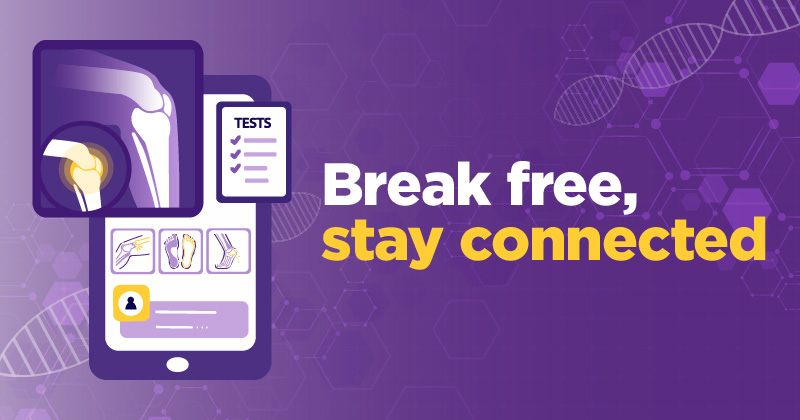How Mobile Apps Help Orthopedists

Today orthopedic surgeons have hundreds of apps to choose from, including smartphone apps for EHR, practice management (PM), and patient engagement. As part of the digital healthcare transformation underway, apps are designed to help streamline workflows, empower patients and improve outcomes. However, many opportunities are still being missed, especially in specialized areas such as orthopedics.
Use of Orthopedic Apps
As the world digitizes old analog systems and moves them to the cloud, apps for orthopedic surgeons, including ortho-specific mobile EHR platforms, make up a vital part of that trend.
Based on surveys from multiple countries,1,2 virtually 100% of physicians now own smartphones, 90% of them perceive apps to be beneficial going forward, and a clear majority already uses apps in clinical settings, including apps for orthopedics. Half of younger physicians and a third of senior physicians claim a high reliance on apps.
Nearly two-thirds, however, remain unsatisfied with the current lineup of medical apps, and half believe that more and better ones need to be created.
Over 80% of orthopedic surgeons believe that apps for medical research will provide the greatest benefit and want apps for orthopedic surgery to be more intuitive.
Apps Designed for Orthopedics
Just over a decade ago, only 66 smartphone apps targeted orthopedic surgeons, and only a quarter of those had more than 10 reviews.3 Today Capterra.com, which claims 1.5 million reviews of 50,000 software products, lists 456 for “orthopedic app,” and Google yields 26.9 million hits for “app orthopedic surgery.”
Among all the apps for orthopedic surgeons, ModMed’s PocketEMATM gives easy access to agendas and patient data on its orthopedic EHR system, EMA®. The app gives EMA users the flexibility to practice whenever and wherever they have internet access, to review the day’s schedule, see other providers’ schedules, access patient histories and chief complaints, call to check in with patients, notate charts while conversations are fresh in mind, dictate notes using Dragon Medical SpeechKit, snap photos and save them to charts, and send prescriptions to pharmacies.
EMA is a digital version of traditional paper charts. Plus, it’s intelligent, adaptive, and available via desktop, laptop and iPad. Ranked #1 among orthopedic EHR systems in independent Black Book™ surveys,4 EMA is designed to help practices save time by reducing typing and scrolling and adapting intuitively to each physician. These 10 questions and answers can help orthopedists determine whether EMA is right for them.
Orthopedic Patient Engagement Apps
Another major opportunity for apps is patient engagement. Smartphone and tablet apps for orthopedic and sports medicine and orthopedic patient education can increase patient involvement in healthcare decision-making, empower patients, help improve outcomes and lower costs. As patients do more with smartphones, orthopedic practices can take advantage of this trend to elevate the patient experience, handle follow-up appointments and increase engagement throughout their care.
In a 2017 report,5 80% of patients had internet access, and 62% of them used it for health information. While 77% of patients owned smartphones and 45% used them for health information, only 28% had adopted healthcare apps. Of this last group, only 11% were referred to those apps by their physicians, which gives your practice an opportunity to differentiate itself by deploying this technology to enhance patient care.
Features ranked highest by patients were appointment reminders, test results, discharge instructions, and communication with physicians. Seventy-one percent felt those features would improve healthcare, and 40% would even pay for apps.
In a 2020 report,6 the use of tablets and smartphones to support medical decisions in the United States was greater among women than men and greater among respondents 18–34 than those 75 and older.
In a 2021 report,7 63% of patients obtained medical information via smartphones and tablets, which was higher among younger and more educated patients, lower among older patients, but only 3% had received app recommendations from their physicians. Features rated highest were medication information, behavioral guidelines and medical records.
ModMed’s APPatient™ app
APPatient is designed to enhance the doctor-patient relationship, streamline practice workflow, reduce no-show rates, improve productivity and empower patients.
With EMA, the app allows patients to manage their own healthcare by requesting appointments, verifying insurance, entering medical histories, signing custom waivers, adding preferred pharmacies, and requesting refills.
With Practice Management, they can use the app to update their demographics and check in for appointments. With ModMed® Telehealth, they can access telehealth appointments. With ModMed® Pay, they can check and pay balances.
References
1. Anjali Ajay Nair, et al., “Smartphone Usage Among Doctors in the Clinical Setting in Two Culturally Distinct Countries: Cross-sectional Comparative Study,” JMIR mHealth and uHealth, (2021 May 10) 9(5):e22599.
2. Florian Dittrich, et al., “Smartphone and App Usage in Orthopedics and Trauma Surgery: Survey Study of Physicians Regarding Acceptance, Risks, and Future Prospects in Germany,” JMIR Formative Research, (2020 November 30) 4(11):e14787.
3. Orrin I. Franko, MD, “Smartphone Apps for Orthopaedic Surgeons,” Clinical Orthopaedics and Related Research, volume 469 issue 7 (July 2011) pp. 2042–8.
4. Black BookTM Research, “Modernizing Medicine Achieves Top EMR Ratings in Seven Surgical and Medical Specialties, 2021 Black Book Physician Satisfaction Survey,” Newswire.com (Tampa, Fla.: March 4, 2021).
5. Jonathan R. Datillo, et al., “Is There an App for That? Orthopaedic Patient Preferences for a Smartphone Application,” Applied Clinical Informatics, (2017 August 16) 8(3):832–44.
6. Aisha Langford, et al., “Use of Tablets and Smartphones to Support Medical Decision Making in US Adults: Cross-Sectional Study,” JMIR mHealth and uHealth, (2020 August 12) 8(8):e19531.
7. Felix Reinecke, et al., “Acceptance, Barriers, and Future Preferences of Mobile Health Among Patients Receiving Trauma and Orthopedic Surgical Care: Paper-Based Survey in a Prospective Multicenter Study,” JMIR mHealth and uHealth, (2021 April 21) 9(4):e23784.
This blog is intended for informational purposes only and does not constitute legal or medical advice. Please consult with your legal counsel and other qualified advisors to ensure compliance with applicable laws, regulations and standards.




